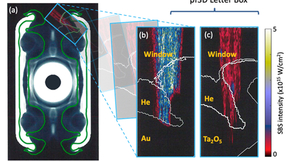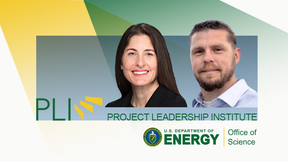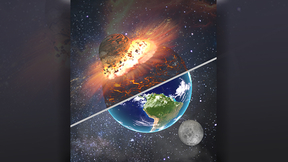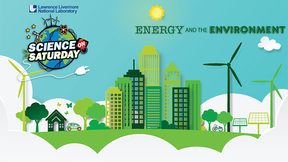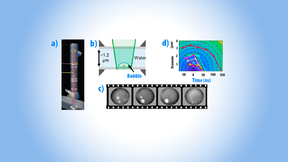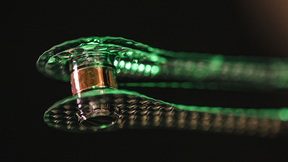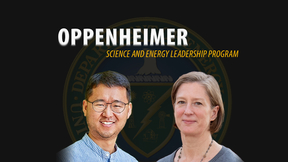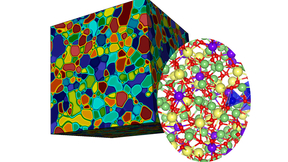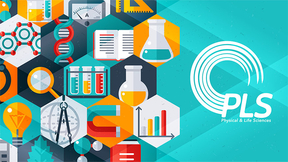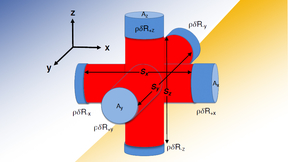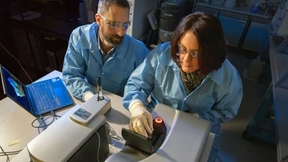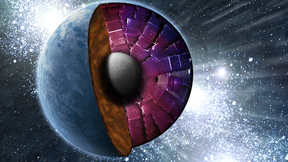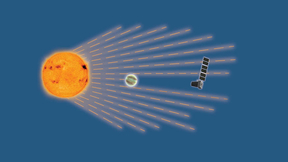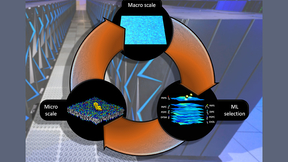Back
Physical and Life Sciences
Putting the pedal to the metal crossing the solid-liquid interface
Most metal alloys are prone to corrosion, which costs hundreds of billions of dollars of damage annually in the U.S. alone. Accurately predicting corrosion rates is a long-standing goal of corrosion science, but these rates depend strongly on the specific operating environment. At the atomic scale, these environmental factors are associated with how quickly and easily…
Researchers take closer look at stimulated Brillouin scattering
A major cost of running the National Ignition Facility (NIF) is managing and mitigating laser-induced damage to optics as the laser beams propagate to the target. Another damage mechanism stems from stimulated Brillouin scattering (SBS) as light travels back from the target and with nearly the same wavelength as the incoming light. This SBS has the potential to cause…
Two LLNL scientists chosen for 2022 DOE Project Leadership Institute
The Department of Energy (DOE) Project Leadership Institute (PLI) has selected Lawrence Livermore National Laboratory’s Lara Leininger and Al Churby as 2022 cohort participants. Members of the PLI cohort have demonstrated their expertise as technical, business systems or project leaders, with significant experience and responsibility for project or organization performance…
Where on Earth did the water come from?
Earth’s supply of water is incredibly important for its ability to sustain life, but where did that water come from? Was it present when Earth formed or was it delivered later by meteorites or comets from outer space? The source of Earth’s water has been a longstanding debate and Lawrence Livermore National Laboratory (LLNL) scientists think they have the answer — and they…
Green, bio-based extraction of rare earths from domestic ores for a sustainable world
Lawrence Livermore National Laboratory (LLNL), Penn State (PSU) and University of Arizona (UA) researchers are partnering with industry collaborator Western Rare Earths (WRE), U.S. subsidiary of American Rare Earths Limited, to use a naturally occurring protein to extract and purify rare earth elements (REEs) from abundant, domestic ore-based feedstocks and waste materials…
‘Science on Saturday’ lecture to cover microalgae’s impact on global carbon cycling and sustainable biofuels
WHO: Lawrence Livermore National Laboratory (LLNL) scientists Xavier Mayali and Ty Samo, along with teacher Erin McKay of Tracy High School, will present “Small Algae, Big World: The Impact of Microalgae on Global Carbon Cycling and Sustainable Biofuels,” the second lecture in the 2022 virtual Science on Saturday series that highlights Energy and the Environment. WHAT:…
Taking a look at tiny bubbles
The formation and collapse of microscopic bubbles is important in a wide range of fields as both a potential mechanism behind tissue damage, such as in cases of blast-wave-induced traumatic brain injury, and as a useful tool for technology applications, such as mechanical properties evaluation, nanomaterials manipulation and surface cleaning. Nanobubbles have been of…
Harnessing a natural geochemical reaction to combat antibiotic resistance
Antibiotics have allowed for the widespread control of bacterial infections, which had been the leading cause of death historically. However, the overuse of traditional antibiotics in humans and animals resulted in the emergence of stronger, more potent bacterial strains that are no longer treatable with conventional antibiotics. Researchers at Lawrence Livermore National…
Capturing microbes in soil and plants
Lawrence Livermore National Laboratory (LLNL) scientists have developed a custom microscope to image microbes in soil and plants at the micrometer scale. Live imaging of microbes in soil would help scientists understand how soil microbial processes occur on the scale of micrometers, where microbial cells interact with minerals, organic matter, plant roots and other…
Nature paper chronicles how researchers achieved burning plasma regime for the first time in a laboratory experiment
After decades of fusion research, a burning plasma state was achieved on November 2020 and February 2021 at Lawrence Livermore National Laboratory’s National Ignition Facility (NIF), the world’s most energetic laser. Obtaining a burning plasma is a critical step toward self-sustaining fusion energy. A burning plasma is one in which the fusion reactions themselves are the…
Two LLNL scientists honored as 2022 Oppenheimer Science and Energy Leadership fellows
The Oppenheimer Science and Energy Leadership Program (OSELP) has selected Lawrence Livermore National Laboratory computer scientist Kathryn Mohror and materials scientist T. Yong Han as 2022 fellows. Established in 2017, OSELP is a distinguished fellowship program that brings together exceptional leaders to explore the complexities, challenges and opportunities facing the…
Breaking down the barriers in all solid-state batteries
Solid electrolytes may overcome key technological hurdles associated with the narrow electrochemical and thermal stability of conventional lithium (Li)-ion and sodium (Na)-ion batteries. However, many solid electrolytes — ceramics in particular — also suffer from poor cycling issues and limitations in their ability to efficiently transport ions. These limitations often…
New environmentally friendly method to extract and separate rare-earth elements
A new method improves the extraction and separation of rare-earth elements—a group of 17 chemical elements critical for technologies such as smart phones and electric car batteries—from unconventional sources. New research led by scientists at Pennsylvania State University and LLNL demonstrates how a protein isolated from bacteria can provide a more environmentally…
Hoagland recognized by American Nuclear Society (ANS)
Dylan Hoagland (PHYS) has won the 2021 ANS Mark Mills award. This award is presented to the student author who submits the best original technical paper contributing to the advancement of science and engineering related to the atomic nucleus. Dylan’s paper, “Solution of the Neutron Transport Equation on Unstructured Grids Using the Parallel Block Jacobi-Integral Transport…
Multiscale simulations of metal additive manufacturing processes
Much of the latent promise of metal additive manufacturing (AM) rests in the potential for controlled creation of spatially tailored microstructures, designed to optimize key build-scale properties through systematic variation across a build. Component optimization possibilities and performance potential expand enormously when this becomes possible. However, the extreme…
Research looks at ‘piston-model’ to understand impacts of asymmetry on ICF implosions
New research conducted at Lawrence Livermore National Laboratory (LLNL) explores the expansion of a classical mechanics model, which has been useful for understanding asymmetries in inertial confinement fusion (ICF) implosions, from a two-piston to a six-piston model to capture higher-mode asymmetries. The work is featured in the Physics of Plasmas. LLNL authors included…
Lab researchers and collaborators to develop new vaccine against three biothreat pathogens
Scientists from Lawrence Livermore National Laboratory (LLNL) and three other institutions are seeking to develop a multi-pathogen vaccine that will protect against three bacterial biothreat pathogens. Led by LLNL, the team includes disease experts from the University of New Mexico Health Sciences Center (UNMHSC), the University of Nevada, Reno School of Medicine (UNR Med)…
Ironing out the interiors of exoplanets
The discovery of more than 4,500 extra-solar planets has created a need for modelling their interior structure and dynamics. As it turns out, iron plays a key role. Lawrence Livermore National Laboratory (LLNL) scientists and collaborators have used lasers at the National Ignition Facility to experimentally determine the high-pressure melting curve and structural…
Pandora mission to study stars and exoplanets continues toward flight
The Pandora mission, co-led by a national laboratory and a NASA flight center, has passed a crucial step on its path to study stars and planets outside our solar system, or exoplanets. After a successful concept study report and system requirements review, NASA approved the mission to continue toward flight. Lawrence Livermore National Laboratory (LLNL) and NASA’s Goddard…
Unprecedented multiscale model of protein behavior linked to cancer-causing mutations
Lawrence Livermore National Laboratory (LLNL) researchers and a multi-institutional team of scientists have developed a highly detailed, machine learning-backed multiscale model revealing the importance of lipids to the signaling dynamics of RAS, a family of proteins whose mutations are linked to numerous cancers. Published by the Proceedings of the National Academy of…



